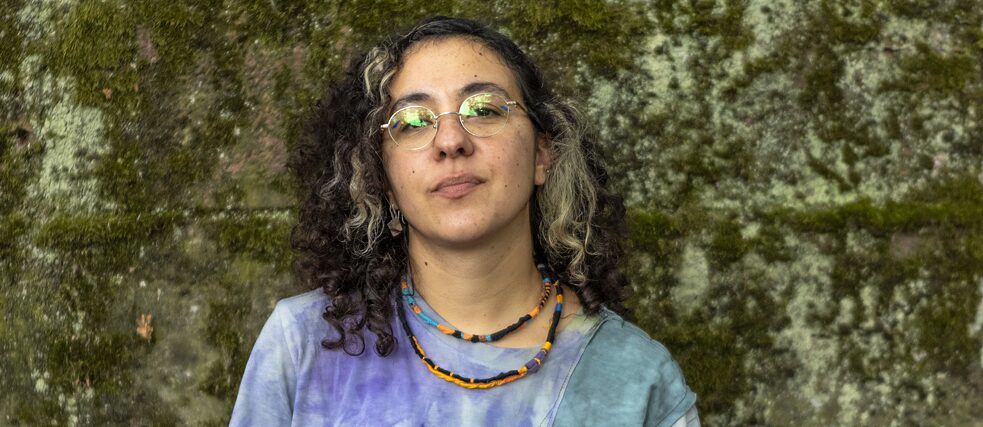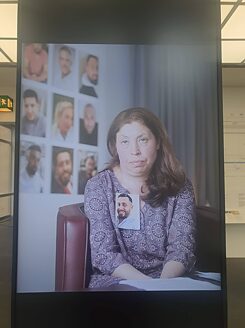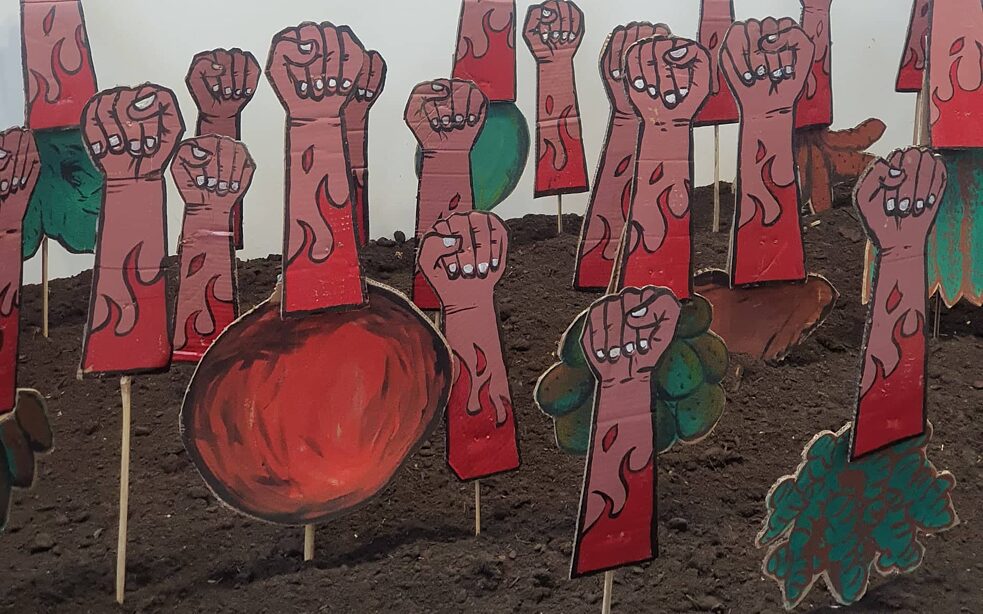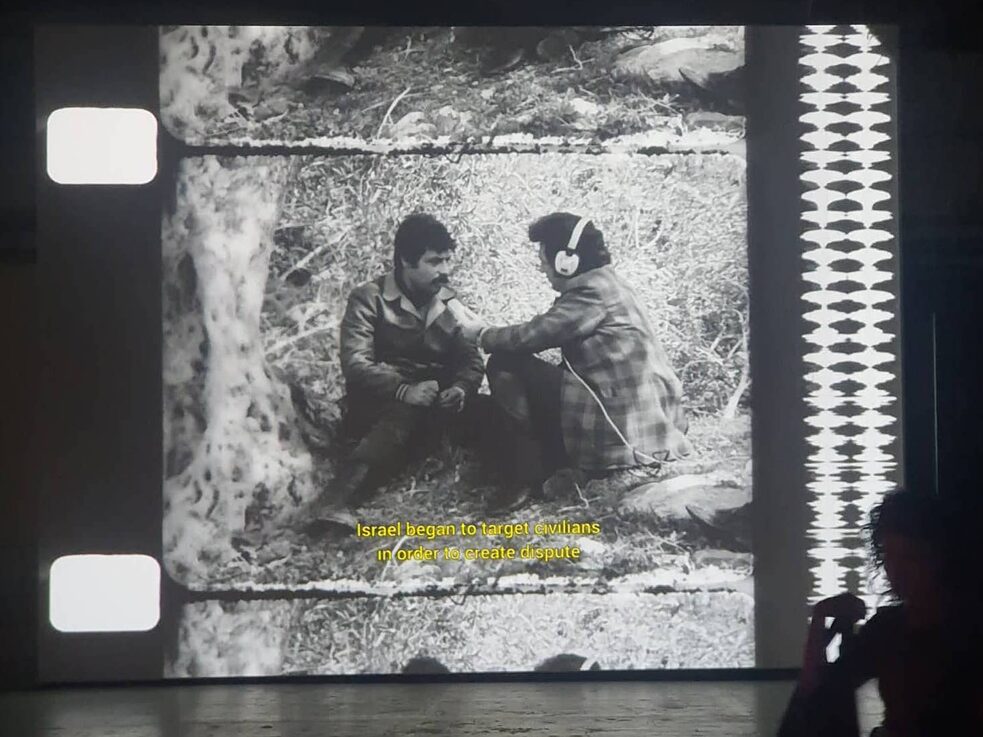Interview
Andriana Lagoudes visits documenta fifteen

From the 26th of June to the 2nd of July 2022 a group visit with curators and artists from different countries in Southeast-Europe to documenta fifteen in Kassel as well as Frankfurt was organised by the Goethe-Institut. Cyprus was represented by Andriana Lagoudes. In this interview we asked her to share her impressions from this visit and her reflections in relation to Cyprus as well as her own work.
You just returned to Cyprus from your visit to the documenta fifteen in Kassel. What have you learnt about the city of Kassel?
The reality is that when I was in Kassel I was fully immersed into the world of documenta fifteen which barely left me any time to contemplate the city. The experience definitely tinted my view of Kassel as a very artistic city but I’m not sure I can come to a conclusion in just three days.
What has fascinated you the most about documenta fifteen? [artworks, artists, experiences, events…]
Anyone who knows me knows that I hold collective practices very close to my heart. Being curated by Ruangrupa, an Indonesian art collective, documenta fifteen gave me access to a variety of art collective working models. The Fridericianum venue is filled with different methods of collectively learning, deconstructing ideas and processing thoughts. Having access to new reference points on how to go about collectives was definitely the most rewarding part for me. In my experience, the finetuning is a matter of processing values, group dynamics, workflow and circular economy models.
Being chosen to go on this trip with a group of cultural practitioners from the Southeastern European region, as defined by the Goethe-Institut, helped me understand and start aligning with these people’s work visions and struggles. And for that I am really thankful to the Goethe-Institut Cyprus and Athens for making this trip happen. Through this trip I have discovered and reaffirmed that there is still a lot to learn to build bridges with cultural workers who operate relatively close to the Cypriot locality. And even more to unlearn in resisting to see our cultures from the established Western point of view.
 Photo of the group outside of the Nest Collective’s multimedia installation at this year’s documenta fifteen. Cultural practitioner’s names from left to right: Eleanna Papathanasiadi,Asena Günal, Ümit Mesci,Senka Ibrišimbegović, Andriana Lagoudes, Ali Cem Doğan, Stefanie Peter, Gjorgje Jovanovik, Burçak Yakıcı, Tena Starčević, Sandra Demetrescu, Vera Mlechevska and Dorina Xheraj-Subashi. | Photo (Detail): Yorgos Prinos
Photo of the group outside of the Nest Collective’s multimedia installation at this year’s documenta fifteen. Cultural practitioner’s names from left to right: Eleanna Papathanasiadi,Asena Günal, Ümit Mesci,Senka Ibrišimbegović, Andriana Lagoudes, Ali Cem Doğan, Stefanie Peter, Gjorgje Jovanovik, Burçak Yakıcı, Tena Starčević, Sandra Demetrescu, Vera Mlechevska and Dorina Xheraj-Subashi. | Photo (Detail): Yorgos Prinos
I also find it extremely important to question the positionality of Goethe-Institut, as a German Cultural Centre which is partially funded by the German government and to reflect on the role it plays in the macro schema of culture in Germany and how this investment uplifts Germany’s socio-cultural capital. As a German cultural body which is positioned to produce work in the location and cultural context of other nationalities and ethnicities in the world, I believe it is really important to keep discussing and negotiating the nuances that arise in producing work, with the intention to respect the local peoples cultural integrity.
What is your biggest take-away or highlight from the overall trip? What was new to you?
 Moment from the group’s visit to the Three Doors exhibition by Forensic Architecture/Forensis, Initiative 19.
| Photo: Andriana Lagoudes
A really important take-away for me was the Forensic Architecture/Forensis exhibition named Three Doors that we visited in Frankfurt at the Frankfurter Kunstverein.
Moment from the group’s visit to the Three Doors exhibition by Forensic Architecture/Forensis, Initiative 19.
| Photo: Andriana Lagoudes
A really important take-away for me was the Forensic Architecture/Forensis exhibition named Three Doors that we visited in Frankfurt at the Frankfurter Kunstverein.
The exhibition investigates three cases of racist murders in Germany that governmental bodies failed to carry out and through; by merging open access information that the internet has to offer. In their way they are establishing that this type of work is not limited to institutions. When institutions fail us we can also use technology to visualise and analyse information. And when the media focuses on the psychological analysis of the killers it is also a choice we can make to prioritise the victim’s narratives and those of their families.
In terms of documenta, my biggest takeaway was definitely that it was the most Eastern and Southern centric art show I have ever seen in the West, and I really applaud that. Ruangrupa as the assigned curators really and truly established a pot of knowledge for the visitors that is somewhat inaccessible for a range of reasons.
To have access to references from the “disregarded” sides of the world and to be able to resonate with the struggle of people whose history I was never made aware of until now; feels monumental in and of itself. This show helped me remember that the earth is a place I still belong to. A place I can still find myself in despite the forces at play trying to convince me daily that my narrative is not a worthy one.
 Example of how The Black Archives displayed sensitive imagery.
| Photo: Andriana Lagoudes
In your view, what is the importance of documenta in general and the fifteenth edition in relation to Cyprus and its art-scene?
Example of how The Black Archives displayed sensitive imagery.
| Photo: Andriana Lagoudes
In your view, what is the importance of documenta in general and the fifteenth edition in relation to Cyprus and its art-scene?
There was an exhibition recently at SPEL in Nicosia on toys. Curated by the Sofia Foundation in a state run gallery, this exhibition displayed images and toys of exaggerated blackface without any historical contextualisation. An act of curation which in the current cultural climate is irresponsible and tone-deaf, as it not only hinders the anti-racism work done by various grassroots organisations but it can help reinforce an uninformed viewer’s subconscious racism.
The black archives at documenta addressed a very similar issue in a simple yet highly effective way (see image). My only hope is that creative practitioners on the island will continue gathering ways in which we can respect people’s generational trauma and grow sensibilities in how to showcase work around such issues. And subsequently continue to apply pressure for Cypriot curatorial practices to catch up with the ethical sensibilities of the world.
I think it is safe to say that creatives in Cyprus are in a constant state of despair. The official infrastructures set up to support more often disregard and disappoint us instead. Take for example the inadequacy exhibited by the Ministry of Education, Culture, Sport and Youth who failed to decide who will represent Cyprus at the Venice Biennale this year.
The dissonance between how the state acts and what creative practitioners need is evident now more than ever. So what do we need to reach a state of experienced symbiosis?
The harvest at documenta fifteen is the way established by Ruangrupa to communicate and disseminate information. Harvest sessions have two main functions; that of artistic recordings or discussions and that of meetings. In processes like these we can create space to nurture our disappointments but also visions for the future. And what better way to do so if not over a meal? The Bangladeshi Pakghor social kitchen and allotment at documenta invited collectives to book a slot and take over their kitchen and prepare a meal for others. Is this process such a farfetched dream for us in Cyprus?
Food is central to our culture so I can’t help but wonder; Who is up for the task of working with the land for fresh produce with the intention to make meals for the artistic community where sharing and harvesting thoughts could metabolise the cultural framework we want to be part of?
Was this your first time visiting Germany? What surprised you the most about Germany, beyond the clichés? How did your experiences in the country and your exchanges with Germans compare to what you had in mind or what you expected?
Honestly I was mostly shocked by the decision the documenta team made to bring down Taring Padi’s People’s Justice (2002), after the pressure applied by German politicians based on the argument that displaying Antisemitism in Germany is not acceptable. Is the German guilt which fuels standing up against Anti-Semitism so fragile that it decapitates the German people at large and the documenta team in this particular case from having a public discussion on site on such an important and complex geopolitical reference? All of this whilst choosing curators such as Ruangrupa who put the Palestinian people’s struggles very central in the spotlight of the show? A show that screens roughly twelve hours of footage from the Japan - Palestine Solidarity archive clearly depicting the atrocities the Palestinian people have had to endure by Israeli forces through time? The same show that was vandalised where Palestinian collective Question of Funding was exhibiting?
Think of it in this way; we have the cases of racist murders examined by Forensic Architecture where responsibility gets diluted in the state’s bureaucracy. But in the case of displaying People’s Justice, the responsibility found a clear target and resolution to satisfy the German government’s status quo. Was the documenta team unprepared to advocate for the matters that Ruangrupa ‘dared’ to give space to? And do we perhaps have a serious case of an institution swaying with the times, romanticising ‘collectives’ but really lacking the skills necessary to support the revolution that some collectives have set out to bring for the Eastern and Southern world?
In the end my biggest disappointment comes from the inability shown by the documenta team to hold substantial public discussions about People’s Justice to address the topics it brought up by drawing a distinction between the Indonesian historical context and modern German politics.
 Part of the exhibition at the Hallenbad Ost part of Documenta Fifteen where the collective Taring Padi presents its archive of artworks from a twenty-two-year period including large-format banners, woodcut posters, and wayang kardus (life-size cardboard puppets). | Photo: Andriana Lagoudes
Part of the exhibition at the Hallenbad Ost part of Documenta Fifteen where the collective Taring Padi presents its archive of artworks from a twenty-two-year period including large-format banners, woodcut posters, and wayang kardus (life-size cardboard puppets). | Photo: Andriana Lagoudes
I, Andriana Lagoudes, am an artist on the path of remembering the future of our past.
In researching the past I identify the values I want to ground as anchors for the future to guide us in collectively investing our resources for the next generations.
My practice communicates in the mediums of speculative thinking, writing, illustration, photography, making and strategy whilst my research focuses on sciences such as ecology and ethnography.
At work I am a service designer for Comuzi and in life I ebb and flow in creative pursuits and Queer communities. I am a member of Faculty at Freedom and Balance (UK) and a member of the Honest Electronics family (CY). I used to teach at the London College of Fashion and was a Lead Mentor for Not a School; an alternative education program at the intersection of ethics and technology by Samsung UK.

